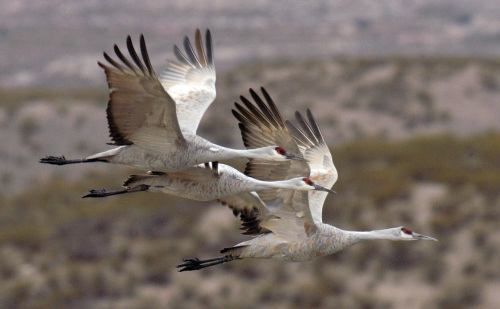PHOENIX (AP) ― From the sandhill crane to the red-faced warbler, rock stars of the birding world have spawned a tourism industry in Arizona that draws bird-watchers from around the world.
“It’s one of the two or three best places in the United States to look for birds,” said David Pashley of the American Bird Conservancy. “Arizona makes a lot of money off of bird-watchers going down to the southeast corner of the state.’’
“It’s one of the two or three best places in the United States to look for birds,” said David Pashley of the American Bird Conservancy. “Arizona makes a lot of money off of bird-watchers going down to the southeast corner of the state.’’

More than 140 bird species are found in southern Arizona, and birding festivals take place year-round throughout the state, including Yuma and in northern Arizona’s Verde Valley. One of the best-known birding destinations is the southeastern city of Sierra Vista, which hosts the annual Southwest Wings Birding and Nature Festival. The Aug. 3-6 festival, in its 20th year, typically draws thousands of participants.
Nearby Tucson will host another major summer event for birders ― the inaugural Tucson Bird & Wildlife Festival, Aug. 17-21. The itinerary will include the Sky Islands Birding Cup fundraiser, where teams will compete to observe the most bird species in a 24-hour period.
Sierra Vista is located near several canyons, the San Pedro River and the Coronado National Memorial, and birds are attracted to the area’s hodgepodge of ecosystems, including mountains and trees along rivers and lakes, according to Joe Yarchin, an Arizona Game and Fish Department project coordinator.
“Those are the strongest kind of birding areas in deserts. People certainly don’t think of Arizona as any kind of mecca for birders,” Yarchin said. “Everyone thinks death and desolation when they think of desert.”
Many out-of-town birders come to see birds that are a rarity where they live. Sierra Vista, which promotes itself as the “Hummingbird Capital,” has documented more than a dozen species of hummingbirds that are found nowhere else in the country. With the Huachuca Mountains’ close proximity to the Sierra Madre mountain ranges of Mexico, birders also get excited at border-crossers.
“A bunch of birds that are Mexican in distribution get into that part of the country,’’ Pashley said. “There are essentially Mexican birds that you can see there that you can’t see anywhere else.”
In Sierra Vista, birders can also get an extraordinary peek at scientists’ effort to record information on hummingbirds. Near the San Pedro River, researchers set up nets and feeders to catch hummingbirds in the fall and spring. Once they’re caught, scientists weigh them and measure them. Daggett said they are released, but not before getting a band around their leg.
“Sometimes they get one that has been coming back year after year,” Daggett said.
Like most birding events, the Southwest festival offers field excursions and lectures. “A lot of folks like to do a 45-minute classroom and then do a carpool and go someplace and put some of the stuff to use in the field,” said Gordon Lewis, one of the festival’s organizers.
Lewis said the June 12 Monument Fire outside Sierra Vista, which burned 122 square kilometers and destroyed 57 homes, hasn’t affected the festival’s plans or bird-watching in general. They have only had to close down one planned trip because of U.S. Forest Service road closures.
Wildfires have also provided fresh fodder for discussion topics, including talks at the Southwest festival addressing how wildlife and habitats bounce back from the disasters.
Pashley, who oversees domestic habitat issues at the American Bird Conservancy, says most fires are good for ecosystems by helping to clear growth. Displaced birds are resilient enough to adapt and find new places to get food. In southern Arizona, where summer brings a monsoon season characterized by increased humidity and rain, burned areas will “green up really fast.”
“My suspicion is those systems will come back and in the long run they’ll be healthier than they were,” Pashley said. “It’s worse for bird-watchers than it is for birds.’’
According to a 2006 U.S. Fish & Wildlife Service survey, birders spent more than $12 billion nationwide on travel and equipment expenses such as cameras, binoculars and bird food. That same report states that about 1.3 million people came to Arizona to observe wild birds, Yarchin said. Arizona birding generated $838 million in trip-related spending the same year, bringing about $1.2 billion in revenue into the state. For tourism offices and communities, that’s a lot of heads and beds, Yarchin added.
“It gets their attention when I go and give my talks to a county board of supervisors or a chamber of commerce,” Yarchin said. “You might just say wildlife viewing is comparable to the combination of hunting and fishing.”
One reason birding may be such a big draw is its leisurely pace.
“It’s a good excuse to go out and get in the fresh air. You don’t have to set a goal of going 10 miles or something. It’s better than sitting in front of the TV,’’ Lewis said.
If You Go...
•Soutthwest Wings Festival: Sierra Vista, Arizona, Aug. 3-6, http://www.swwings.org/
•Tucson Bird & Wildlife Festival: Tucson, Arizona, Aug. 17-21, http://tucsonaudubon.org/
•Audubon Arizona: http://az.audubon.org/
•Arizona Tourism: Birding information from the state office of tourism, http://www.arizonaguide.com/things-to-do/nature/birding-wildlife/arizona-birding



![[AtoZ into Korean mind] Humor in Korea: Navigating the line between what's funny and not](http://res.heraldm.com/phpwas/restmb_idxmake.php?idx=644&simg=/content/image/2024/04/22/20240422050642_0.jpg&u=)

![[Exclusive] Korean military set to ban iPhones over 'security' concerns](http://res.heraldm.com/phpwas/restmb_idxmake.php?idx=644&simg=/content/image/2024/04/23/20240423050599_0.jpg&u=20240423183955)

![[Herald Interview] Why Toss invited hackers to penetrate its system](http://res.heraldm.com/phpwas/restmb_idxmake.php?idx=644&simg=/content/image/2024/04/22/20240422050569_0.jpg&u=20240422150649)
![[Graphic News] 77% of young Koreans still financially dependent](http://res.heraldm.com/phpwas/restmb_idxmake.php?idx=644&simg=/content/image/2024/04/22/20240422050762_0.gif&u=)






![[Exclusive] Korean military to ban iPhones over security issues](http://res.heraldm.com/phpwas/restmb_idxmake.php?idx=652&simg=/content/image/2024/04/23/20240423050599_0.jpg&u=20240423183955)



![[Today’s K-pop] Ateez confirms US tour details](http://res.heraldm.com/phpwas/restmb_idxmake.php?idx=642&simg=/content/image/2024/04/23/20240423050700_0.jpg&u=)